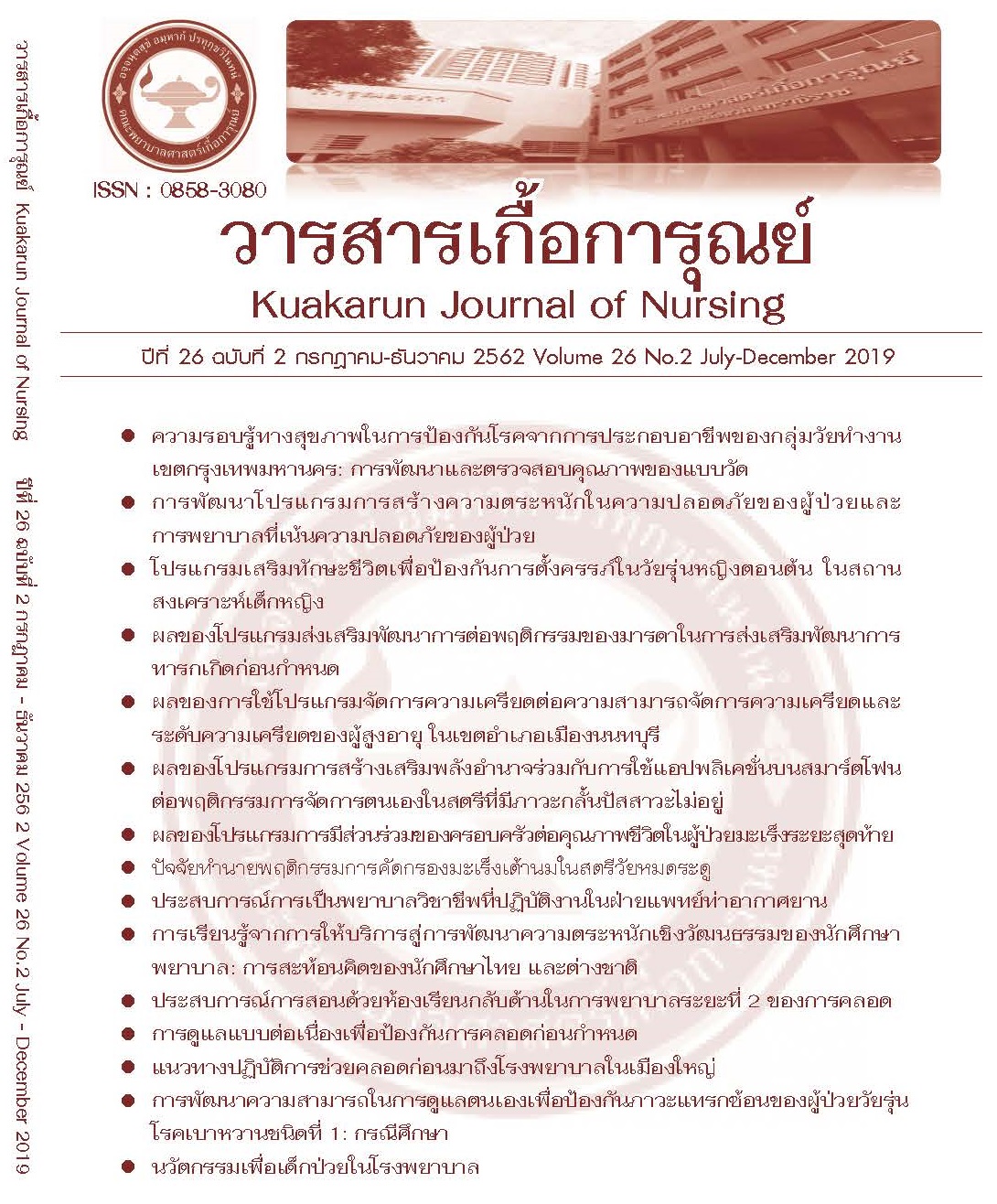ความรอบรู้ทางสุขภาพในการป้องกันโรคจากการประกอบอาชีพ ของกลุ่มวัยทำงาน เขตกรุงเทพมหานคร: การพัฒนาและตรวจสอบคุณภาพของแบบวัด
การพัฒนาและตรวจสอบคุณภาพของแบบวัด
คำสำคัญ:
แบบวัดความรอบรู้ทางสุขภาพ, การป้องกันโรคจากการประกอบอาชีพ, ความรอบรู้สุขภาพในวัยทำงานบทคัดย่อ
โรคจากการประกอบอาชีพในกลุ่มวัยทำงาน ส่งผลกระทบต่อร่างกาย จิตใจ และเศรษฐกิจของ ผู้ป่วยซึ่งอาจทำให้ขาดงานหรือต้องออกจากงานและสูญเสียรายได้ ความรอบรู้ทางสุขภาพนับเป็นตัวแปรสำคัญของการพัฒนาพฤติกรรมสุขภาพ และการป้องกันโรคจากการประกอบอาชีพของกลุ่มวัยทำงาน จากการทบทวนวรรณกรรม พบว่ายังไม่มีแบบวัดความรอบรู้ทางสุขภาพในการป้องกันโรคจากการประกอบอาชีพฉบับภาษาไทย การวิจัยนี้ใช้ระเบียบวิธีวิจัยในการสร้างเครื่องมือวิจัยและมีวัตถุประสงค์เพื่อพัฒนาแบบวัดความรอบรู้ทางสุขภาพในการป้องกันโรคจากการประกอบอาชีพทั้งด้านความตรงและความเชื่อมั่น งานวิจัยดำเนินการโดยการสร้างแบบวัดความรอบรู้ทางสุขภาพในการป้องกันโรคจากการประกอบอาชีพของกลุ่มวัยทำงานในเขตกรุงเทพมหานคร ซึ่งพัฒนาขึ้นตามกรอบแนวคิดของโซเรนเซน แบบวัดได้รับ การตรวจสอบความตรงตามเนื้อหา โดยผู้ทรงคุณวุฒิ 5 ท่าน จากนั้นนำแบบวัดไปใช้กับกลุ่มตัวอย่าง 30 คน เพื่อหาความเที่ยงด้วยสัมประสิทธิ์แอลฟาของครอนบาค วิเคราะห์ข้อมูลด้วยสถิติเชิงพรรณนา สถิติสหสัมพันธ์ ของเพียร์สันและการวิเคราะห์องค์ประกอบเชิงยืนยัน
ผลการศึกษาพบว่าคุณลักษณะของประชากรกลุ่มตัวอย่างจำนวน 600 คน ส่วนใหญ่เป็นเพศหญิง (62%) ค่าเฉลี่ยความความรอบรู้ทางสุขภาพในการป้องกันโรคจากการประกอบอาชีพเท่ากับ 4.23 แบบวัด ประกอบด้วยข้อคำถาม 20 ข้อ มีค่าความเชื่อมั่นทั้งฉบับเท่ากับ 0.94 มีค่าดัชนีความสอดคล้องอยู่ระหว่าง 0.6-1.0 ผลการวิเคราะห์องค์ประกอบเชิงยืนยันพบว่าแบบวัดมีความกลมกลืนกับข้อมูลเชิงประจักษ์ผ่านเกณฑ์ยอมรับได้ (χ2 = 388.99, df = 164, CFI = 0.99, GFI = 0.94, TLI = 0.99, RMSEA = 0.05) และสนับสนุนว่าประกอบด้วยองค์ประกอบ 4 ด้าน ได้แก่ 1) การเข้าถึงข้อมูลสุขภาพ 2) การเข้าใจข้อมูลสุขภาพ 3) การวิเคราะห์ข้อมูลสุขภาพและ 4) การประยุกต์ใช้ข้อมูลสุขภาพ ดังนั้น แบบวัดความรอบรู้ทางสุขภาพของกลุ่มวัยทำงานที่ได้พัฒนาขึ้นมีความเหมาะสมและสามารถนำไปใช้ในการประเมินความรอบรู้ทางสุขภาพในการป้องกันโรคจากการประกอบอาชีพได้
เอกสารอ้างอิง
สำนักโรคจากการประกอบอาชีพและสิ่งแวดล้อม กรมควบคุมโรค กระทรวงสาธารณสุข. (2561). โรคจากการ ประกอบอาชีพ. สืบค้นเมื่อ 10 พฤศจิกายน 2561 จาก https://envocc.ddc.moph.go.th/ contents/ view/56.
Andersen, L. L., Clausen, T., Burr, H., & Holtermann, A. (2012). Threshold of musculoskeletal pain intensity for increased risk of long-term sickness absence among female healthcare workers in eldercare. PLoS One, 7(7), e41287. doi:10.1371/journal.pone.0041287
Briggs, A. M., Jordan, J. E., O’Sullivan, P.B., Buchbinder, R., Burnett, A. F., Osborne, R. H., & Straker, L. M., (2011). Individuals with chronic low back pain have greater difficulty in engaging in positive lifestyle behaviours than those without back pain: An assessment of health literacy. BMC Musculoskeletal Disorders, 12(161), 1-10. doi:10.1186/1471-2474-12-161
Chang, C.J., Yang, H.H., Wang, Y. F., & Li, M.S. (2015). Prevalence of sick building syndrome-related symptoms among hospital workers in confined and open working spaces. Aerosol and Air Quality Research, 15, 2378-2384. doi:10.4209/aaqr.2015.01.0040
Chantaracherd, P. (2015). The office syndrome: A potential risk factor of TMD and headache, maybe vice versa? Mahidol Dental Journal, 35(3), 265-272.
Diamantopoulos, A. & Siguaw, J. A., (2000). Introduction to LISREL: A guide for the uninitiated. London: SAGE Publications, Inc.
Fornell, C., & Larcker, D. (1981). Evaluating structural equation models with unobservable variables and measurement error. Journal of Marketing Research, 18(1), 39-50. doi:10.2307/3151312
Hair, J. F., Black, W. C., Babin, B. J., & Anderson, R. E. (2010). Multivariate data analysis: A global perspective. (7th ed.). Upper Saddle River, New Jersey: Prentice-Hall.
Hernández Martín, M. M., Romero-Saldaña, M., Pacheco Del Cerro, J. L., Alonso-Safont, T., Molina-Recio, G., & Meneses Monroy, A. (2019). Occupational and work-related disease underestimated and linked to temporary disability through primary health care services. Journal of Nursing Management, 27(6), 1140-1147. doi:10.1111/jonm.12785
International Labor Organization. (2019). World statistic. Retrieved August 20, 2019, from https://www.ilo.org/moscow/areas-of-work/occupational-safety-and-health/WCMS_ 249278 /lang--en/index.htm
Jordan, J. E., Buchbinder, R., Briggs, A. M., Elsworth, G. R., Busija, L., Batterham, R., & Osborne, R. H. (2013). The Health Literacy Management Scale (HeLMS): A measure of an individual's capacity to seek, understand and use health information within the healthcare setting, Patient Education and Counseling, 91(2), 228-235. doi:10.1016/j.pec.2013.01.013
McDonald, M., DiBonaventura, M. D., & Ullman, S. (2011). Musculoskeletal pain in the workforce: The effects of back, arthritis, and fibromyalgia pain on quality of life and work productivity. Journal of Occupational and Environmental Medicine, 53(7), 765-770. doi:10.1097/JOM.0b013e318222af81
Nunnally, J. C., & Bernstein, I. H. (1994). Psychometric theory. (3rd ed.) New York: McGraw-Hill.
Osborne, R. H., Batterham, R. W., Elsworth, G. R., Hawkins, M., & Buchbinder, R. (2013). The grounded psychometric development and initial validation of the health literacy questionnaire (HLQ). BMC Public Health, 13, 2-17.
Pituth, K. A., & Stevens, J. P. (2016). Applied multivariate statistics for the social sciences (6th ed.). New York: Routledge.
Polit, D.F. & Beck, C.T. (2017). Nursing research: Generating assessing evidence for nursing practice (10th ed.). Philadelphia: Wolters Kluwer.
Rushton, L. (2017). The global burden of occupational disease. Current Environmental Health Reports, 4, 340–348. doi:10.1007/s40572-017-0151-2
Sorensen, K., Brouche, S. V., Fullam, J., Doyle, G., Pelikan, J., Slonska, Z., & Brand, H., (2012). Health literacy and public health: A systematic review and integration of definitions and models. BMC Public Health, 12, 1-13. doi:10.1186/1471-2458-12-80
Takala, J., Hämäläinen, P., Saarela, K. L., Yun, L. Y., Manickam, K., Jin, T. W., … Lin, G. S. (2014). Global estimates of the burden of injury and illness at work in 2012. Journal of Occupational and Environmental Hygiene, 11(5), 326–337. doi:10.1080/15459624.2013.863131
Wong, B. K. (2012). Building a health literate workplace. Workplace Health & Safety, 60(8), 363-369. doi:10.1177/216507991206000806
World Health Organization [WHO]. (1998). Health Promotion Glossary. Geneva: WHO Publications.















